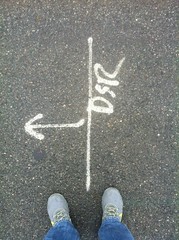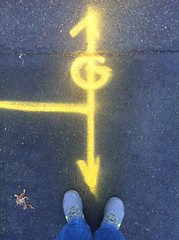Dan Paluska is an artist, engineer and educator who works with kinetic, robotic, and cultural systems. He has a BS, MS and ABD from MIT in Mechanical Engineering.
Dan and I have a mutual obsession with the Day 6 Plotwatcher Time-lapse Video Camera. I was delighted to find someone with the same compulsion and greatly appreciate his insightful perspective.
James Grady: I started shooting time-lapse back in November. I was just shooting… I was fascinated with what was happening. I was asking myself questions like, what happens when I put all these days in chronological order? Where does the narrative go? Is there a narrative? Can it be like William Burroughs’ Cut-ups, creating narrative from randomness? Or is it just interesting to see my life in time-lapse? I don’t know what it’s doing. I’m just exploring and liking the form that I’m finding, but I’m trying to dig a little deeper into it.
I’m really more interested in what you’re doing. What drew you to time-lapse, why did you shoot time-lapse everyday (for eighteen months)? When did this start? Why?
Daniel Paluska: It’s a process of capture. Then sometimes I look at it, I’m like, “Why am I watching this?” At least theoretically speaking, the original thought was OMPD, one minute per day of review. I can afford… If I’m gonna sit eight hours at a computer to watch one minute of a video, which presents to me how I spent my eight hours at the computer. That was kind of the initial input as for that. It’s continued now; maybe I feel it’s almost like a theatrical thing, and it has some amount of thinking about privacy, and all these other issues. In terms of that my phone company, and my internet service provider, and G-mail, and all these other people know all this stuff about me. So I was like, well I’m gonna capture myself, and put it into the public domain as well, so it’s not some corporate thing.
Another thing that came to me from taking a lot of time-lapse movies is that of course we’re taking pictures all the time. We’re taking movies all the time. We accumulate a lot of inventory, right? Just massive amounts of inventory. Most of that zooms in on time, and time-lapse zooms out on time. So that seems to me to be an interesting feature of it that brings these different textures and tempos out that you’re not used to seeing because other devices don’t usually act this way. So it’s a sort of a slightly unique feature of time-lapse.
JG: That’s nice to think about as opposed to seeing a small vignette of time. We’re really able to look at a whole span over the day even though it’s at a phrenetic pace. It gives a wider angle.
DP: I made six-month compilations of time-lapse videos—these in terms of the pace of life, like the trees versus the building. This is something that I really started to notice a lot more of. That the trees and the natural things are always moving, and so much of our life is. A lot of times, indoor spaces are really boring, and outdoor spaces shot in time-lapse are never boring. There are always clouds, there are always trees, there’s always something happening, and that to me I found to be quite an interesting piece of the feedback. All that said it still is whatever it does, the time-lapse camera does its one thing, and I spent a certain amount of time with this one particular thing. That thing will reinforce itself to me. I certainly enjoyed carrying it around.
JG: Did it give you a sense of—I don’t want to say purpose—but some sort of connection to your surroundings that was different than if you didn’t have it?
DP: I did quite often have this feeling that if I was standing in line, it’s like, oh I’m standing in line—this is it. Going back to the capturing, and publishing my information that this is my life, and with this camera it’s not like I stop and I select this moment. It’s like if I really want this moment to be captured, then I have to sit here. I can’t quickly take the picture, and run off. I’ve gotta sit there, and if I want it to be a significant portion by movie, then it’s a significant portion of my time. So in that sense it made me appreciate time and attention as these real functional characters of my experiential existence. I always have two ways of viewing my life at any given point in time, there’s the experiencing self, perfectly in the present flowing through, and there’s the remembering self who has the pictures, the narrative, the stories. I went on a vacation for two weeks—the last day was really good. And that’s how I remember it. What about the rest of the two weeks? How was I flowing through the rest of the two weeks? With time-lapse of course it gives me a record of the entire thing. It is still a narrow record of the experience. It’s only visual you know. It’s choppy, whatever, it is a variable. But it tells a different story of time.
JG: Totally agree. I think when people are on vacation or they’re taken out of their routine, they’re in this space of awareness or openness, but I think that space can be captured all the time if we are more aware, if we’re paying attention. There doesn’t need to be differences between your “regular” time and your “vacation” time.
DP: Twenty-four hour tourist.
JG: That’s a good name.
DP: I think that’s very powerful. A very powerful mindset. To be in the observational. To be in the present.
JG: I think that’s what this whole process is about, discovering more and being in the present. Then you find these moments, and they inspire you and lead to more and more.
DP: Exactly.
JG: How does the point of view of the time-lapse camera play a role in your work? It has no viewfinder, so you can’t see what you’re shooting. You have a general idea but you never know until you download the files. Do you have thoughts on this position?
DP: People have said to me that… it’s really nice that the viewpoint can be in the third person. It’s really nice that I can set it on the far corner of the room, and I can see myself from a distance, and sometimes it is in more of a first person perspective. But it’s cool that it can be a third person perspective.
JG: When you show your work what are some of the other questions you get, beyond “why do you shoot time-lapse?”
DP: I guess a lot of people say what do you learn? I’d say I learned lots of things in the eighteen months. You notice the trees more. The things in this room don’t move, well they do move, but they are in very slow decay. Everything that we build that’s nice and shiny, and has very round corners is in very slow decay. The plants are always bubbling. The sky is always bubbling. And then me, myself, I am having some pattern of breath, some pattern of heartbeat, some patterns: I’m stressed, I’m not stressed, I’m hungry, I’m not hungry, I’m sleepy, I’m not sleepy. In the time-lapse is this focus on a particular rhythm. Be that the ten-second rhythm, or the thirty-second rhythm, and so on. I think it really made me think a lot more about the pace of life, and how I interact with the machinery around me. The ticking of the clock, the nine to five bells, these are all these external timers that we have. This is this timer that’s like taking a picture every thirty seconds right? How that relates to my internal state and my experience in the world. I think that’s something that really seems was tied to this process of observation.
JG: I think that’s great, and I haven’t thought of it, but I think that’s sort of what I’m searching for, a process of awareness.


